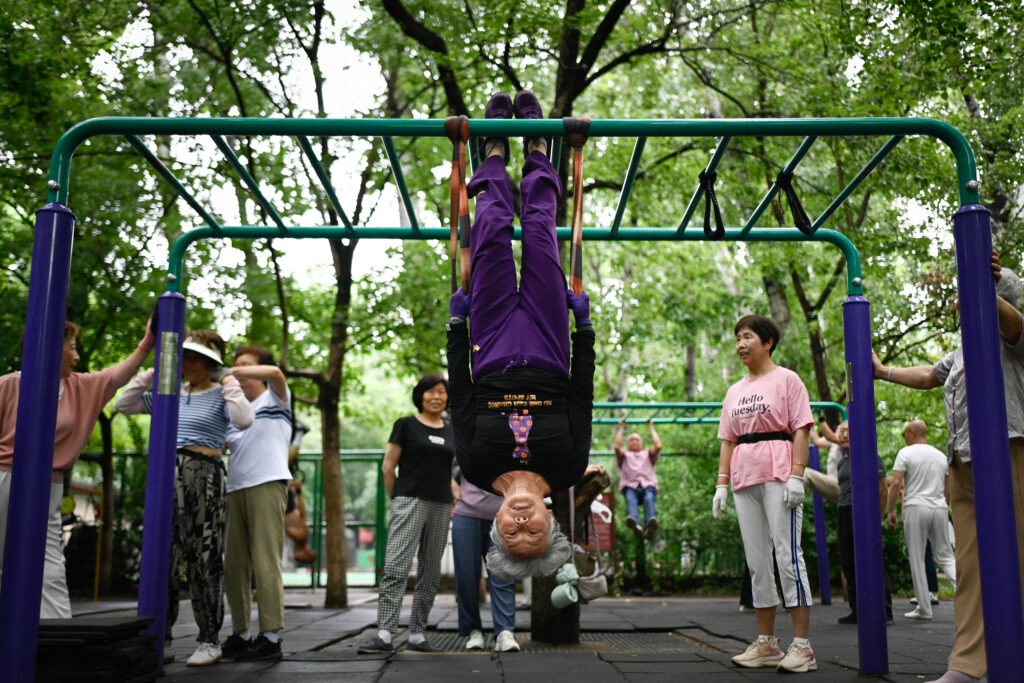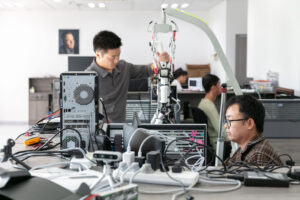AI, China’s Invisible Scaffolding

In these hot summer mornings, I go with my son to the park to look at swans. One day, we passed by a government-run canteen, and I stopped to pick up a snack for him. I noticed, mounted on the wall, a huge screen that captured data of the most banal kind: the patrons’ age group, the most commonly ordered dish. A high-tech control room was on display as the elderly diners ate their breakfast. I did a bit of research and discovered that this place was a pioneer project that might be going national soon. In cities across China, government-subsidized food halls for seniors use AI to optimize ingredient ordering, reduce food waste, and track nutritional data. These smart canteens, often tucked into public housing complexes or community centers, demonstrate how AI-enhanced cost-effectiveness allows the state to provide services that would once have been seen as too expensive to sustain.
In my area of Shanghai, many of the elderly are living alone in small apartments, sustained by a Chinese form of rent control. Shanghai’s infrastructure simultaneously caters to upper-middle-income families like my own, with expectations that the city is as livable London or New York, and to the elderly pensioners who skip meals to save money. As the city tries to prepare for an aging population, AI and big data are seen as the magic bullet that can help the government solve its problems. These big ideas run the risk of becoming mindless box-ticking when officials implement them, and yet the momentum has built up: China’s next Five-Year Plan, the one for 2026–30, is known as the “AI+” plan—as in, whatever the government does, add AI. Military? Add AI. Healthcare? Add AI. Smart factories? AI. Sell subsidized breakfast to seniors? AI.
We’ve all heard a lot about China’s focus on infrastructure—usually tangible, physical objects: railways and airports, apartment buildings and bridges. The result has been a society with very strong bones but, in places, scrawny muscles. The metro system is amazing; the hospital has long waits and people in the countryside can’t send their kids to good schools. This creates not just a moral issue but a practical one, too, for a state whose primary resource is its own population. The evolutionary theorist Stephen Jay Gould once said, “I am, somehow, less interested in the weight and convolutions of Einstein’s brain than in the near certainty that people of equal talent have lived and died in cotton fields and sweatshops.” Ever practical, the Chinese government wonders: Is the answer to our semiconductor problem an unacknowledged talent toiling in a sweatshop right now? About 40%–50% of the Chinese population is rural but holds less than one-third of the country’s disposable income: How can these people innovate, produce, and consume as much as their urban brethren? The Chinese government doesn’t want to lose to path-dependent poverty a potential genius lurking in a mountain village. How can it rapidly build out a soft infrastructure—education, healthcare—that can nurse its population toward being its best, most productive self? It’s become common to claim that Chinese people don’t consume much because they’re saving for expensive healthcare. Can AI and big data somehow solve this? To find out, I headed to Dalifornia, a temperate area around the city of Dali, in Western Yunnan, where urban tourists meet rural poverty—and innovation.
The province of Yunnan—meaning “south of the clouds” in Chinese—has traditionally been seen as a peripheral region, part of what the anthropologist and political scientist James C. Scott called “zomia.” The many small ethnic groups tucked away here have traditionally sought to escape an overbearing government. In recent years, Yunnan’s authorities have deployed AI and digital platforms to modernize the province’s medical system. Its medical centers in four minor regional towns don’t just house new buildings and equipment; they are digitally networked hubs. AI-assisted diagnostic systems help village doctors identify common illnesses. Medical imaging centers use AI to interpret scans and share results across facilities. And remote consultation platforms allow top specialists in Kunming, Yunnan’s capital, or even Shanghai to guide treatments in remote towns.
In fact, Shanghai has been formally paired with Yunnan, like a smart student is assigned to tutor a student who is lagging. The Shanghai-Yunnan pairing assistance program (沪滇对口帮扶协作) is a key part of China’s targeted poverty-alleviation and rural-revitalization strategy, under which wealthier coastal provinces and cities provide financial, industrial, and technical support to less-developed regions. The idea isn’t just wealth transfer; it’s a policy that the Chinese government calls “blood-forming” (造血式帮扶): Transfusions of capital and technology from Shanghai—like the brand new, fancy hospitals I toured—are injected to change the social metabolism of the region. All of China’s richer provinces and cities have such pairings; Beijing, for example, is coupled with Inner Mongolia. Anyway, the AI Smart Total Inspection System developed through the Shanghai-Yunnan collaboration generates preliminary reports in minutes, enabling remote verification by top-tier doctors. The far-flung villages of the Tibetan plateau, along the Myanmar border, or in the Nujiang Lisu Autonomous Prefecture receive diagnoses from distant doctors or doctors who just let AI make diagnoses in their place.
The results are striking. According to official figures, AI-supported primary care in Yunnan provided over 26 million diagnostic suggestions in just one year—the province’s population is just under 47 million—reducing misdiagnosis rates and unnecessary referrals. Such initiatives aren’t just closing rural-urban gaps; they’re reframing what’s possible for public healthcare in a vast, diverse country. In a way, AI is a perfect match for rural Chinese healthcare needs. AI can take on the function of a doctor, and diagnose illnesses, but it can’t replace the nurse, who changes the bed pan, gives the patient comfort, and helps to establish the patient’s trust in the medical system more broadly. The skills of the nurse are not hard to find in rural China; it’s the doctor, with high-end medical equipment, who has been missing. Building hospitals in every village would be extremely expensive. But every villager has a smartphone.
Private companies and entrepreneurs are very much aligned with this vision. On July 4, just as the United States seemed to be heading further down the drain, I toured the Jomoo Innovation Center in Xiamen, on the southern coast, which was built by the international architecture firm OMA. At the door, I was greeted with a photograph of key users of the toilets: Bill Gates, David Beckham, and Donald Trump have all sat on these thrones. The Jomoo complex is dedicated to research on smart sanitation and water systems—areas in which China hopes to harness AI to meet environmental and public health goals (in addition to helping Jomoo get an edge over its Japanese competitor Toto and its American competitor Kohler). Since the Chinese domestic market is saturated by competition, companies like Jomoo are planning to go overseas, part of a torrent of Chinese companies dealing in automobiles or biotech, fashion or coffee shops. If Chinese exports were once underpinned by low-cost labor, increasingly Chinese factories have no workers at all. Several of Jomoo’s are “lights out factories.” And if a factory requires no workers and tariffs are imposed when goods cross borders, there is no good reason why Jomoo or its more famous brethren such as Haier (refrigerators), Midea (air conditioning), or Foxconn (phones) should not build such factories overseas.
The BYD EV-car factory in Szeged, Hungary, for example, will be largely automated; I was told the CATL batteries factory in Arnstadt, Germany, already is. Foreign companies that are closely enmeshed with the Chinese manufacturing system have adopted these methods as well: The Tesla Gigafactory in Shanghai, for example, is at the forefront of the trend. As Chinese people get older and sicker, robots can help to provide them with inexpensive breakfasts and respond to their medical concerns; in factories and farm fields, robots will keep the system humming along. If a Chinese company uses Chinese technology to manufacture products in Europe without a single worker in the factory, is it still Chinese? These theological questions aside, the Chinese manufacturing system is competing with itself, rather than any foreign rival, to get better and better at doing what it does; the process is grueling for domestic competitors (it’s called 内卷, “involution”), but makes it ever-more challenging for anyone else to catch up.
Of course, this emerging soft infrastructure brings challenges: about data privacy, algorithmic bias, and the risk that efficiency might substitute for human empathy. But there’s no doubt that China is moving beyond concrete and steel to build an invisible scaffolding of code, sensors, and algorithms that could redefine the relationship between citizen and state. If the upcoming Five-Year Plan unfolds as many expect, AI+ will not merely be an economic or industrial policy: It will be the nervous system of a new kind of government.
Jacob Dreyer is a writer and editor based in China. Publishing frequently in the NYTimes, Nature, and NOEMA, he is working on a book about how scientific and technological changes are impacting the US, China, and everybody else.

